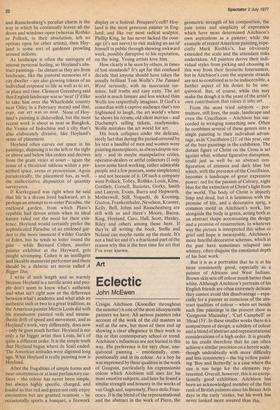Art
Eclectic
John McEwen
Craigie Aitchison (Knoedler throughout the summer) is one of the most idiosyncratic painters we have. All serious painters take account of the work of the old masters as well as the new, but most of them end up showing a clear allegiance in their work to this or that contemporary school or trend. Aitchison's influences are not buried in this way. His preference is for very clear, une- quivocal painting — emotionally, com- positionally and in its colour. As a boy he was impressed by these qualities in the work of Gauguin, particularly his expressionist colour which Aitchison still uses for his most emotive subjects, and later he found a similar strength and honesty in the works of van Gogh and, supremely, Piero della Fran- cesca. It is the blend of the representational and the abstract in the work of Piero, the geometric strength of his composition, the pale tones and simplicity of expression which have most determined Aitchison's own aspirations as a painter; while the example of recent American painting, espe- cially Mark Rothko's, has obviously extended the scale and the attendant risks undertaken. All painters derive their indi- vidual styles from picking and choosing in this way from their favourite forerunners, but in Aitchison's case the separate strands are not so combined as to be indiscernible, a further aspect of his desire to be une- quivocal. But, of course, while this may make the dough it is the yeast of the artist's own contribution that raises it into art.
From the most tried subjects — por- traiture, still lives, the nude, landscape and even the Crucifixion — Aitchison has suc- ceeded in wringing something new. Often he combines several of these genres into a single painting to their individual advan- tage, as,in 'Crucifixion (2)' of this year, one of the best paintings in the exhibition. The distant figure of Christ on the Cross is set against what, without figurative disruption, could just as well be an abstract con- figuration of crimson and dark blue but which, with the presence of the Crucifixion, becomes a landscape of great expressive power: red for the passion of Calvary, night blue for the extinction of Christ's light from the world. The body of Christ is abjectly limp and dead, but it is luminous with the promise of life, and a decorative sprig, a common motif in Aitchison's work, lies alongside the body in green, acting both as an abstract shape accentuating the design and a promise of resurrection. In whatever way the picture is interpreted this sehse of grief and hope is inescapable. Aitchison's more fanciful decorative schemes, which in the past have sometimes relapsed into whimsy, often disguise the emotional depth of his best work.
But it is as a portraitist that he is at his most consistently good, especially as a painter of Africans and West Indians. Brown skin sets off colour much better than white. Although Aitchison's portraits of his English friends are often extremely delicate they cannot avoid this disadvantage — espe- cially for a painter so conscious of the abs- tract qualities of colour — when set beside such fine paintings in the present show as 'Gorgeous Macaulay', 'Carl Campbell' or 'Head (3)'. In these smaller works there is a compactness of design, a subtlety of colour and a blend of abstract and representational considerations of a high order. It is greatly to his credit therefore that he can often achieve-a similar precision on a heroic scale, though undoubtedly with more difficulty and less consistency — the big yellow paint- ing 'Boy and Butterfly' is a case where the size is too large for the elements rep- resented. Overall, however, this is an excep- tionally good exhibition. Aitchison has been an acknowledged member of the first rank of British painters since his Beaux Arts days in the early 'sixties, but his work has never looked more assured than this.


































 Previous page
Previous page